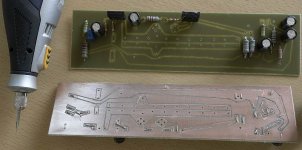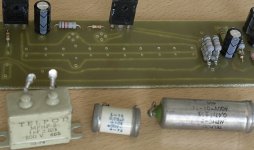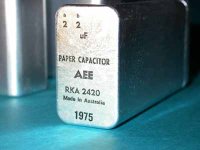What do they mean by saying "high-speed transformers" ? Very high efficiency ?
Come on! This is completely commercially bull ****.
Even Goldmund is not able to change nature's laws....
Could they mean, that several trafos in parallel, imply also several rectifying diode bridges in parallel, hence the voltage drop and internal resistance of paralleled conducting diodes become negligible, hence higher maximum peak current to load etc.
Maybe, but what that has to do with "high-speed". IMO this is one of many attempts to impress the rich but ignorant customer.
Hi
maybe slighly offtopic
here is my approach for the Andrea's original version
pcb created in expresspcb
"etched" with a minigriner in 20 minutes
partly assembled, watch the place for parallel output caps🙂
Attachments
Hi
maybe slighly offtopic
here is my approach for the Andrea's original version
pcb created in expresspcb
"etched" with a minigriner in 20 minutes
partly assembled, watch the place for parallel output caps🙂
Hi
maybe slighly offtopic here is my approach for the Andrea's original version
pcb created in expresspcb "etched" with a minigriner in 20 minutes
partly assembled, watch the place for parallel output caps🙂
It is quite a reasonable solution. How do you plan to connect shunt capacitors to the "cluster" output electrolytics?
It is quite a reasonable solution. How do you plan to connect shunt capacitors to the "cluster" output electrolytics?
?
maybe solder from the copper side?
Depending on the place in enclosure😕
?
maybe solder from the copper side?
Depending on the place in enclosure😕
I would suggest you to consider Wima MKP 22uF polypropylene caps, seems possible to put 3-4pcs of them from the copper side.
I would suggest you to consider Wima MKP 22uF polypropylene caps, seems possible to put 3-4pcs of them from the copper side.
I have paper in oil caps - it would be a bit of hard to mount them, but...
here are the possibilities.
You can see paralleled 1,5 ohm 2W low impedance resistors (unsoldered) for 1,5/3A switch.
Input cap I am going to solder directly to input chinch.
Attachments
I have paper in oil caps - it would be a bit of hard to mount them, but...
here are the possibilities.
You can see paralleled 1,5 ohm 2W low impedance resistors (unsoldered) for 1,5/3A switch.
Input cap I am going to solder directly to input chinch.
Those paper-in-oil caps (if we speak about not too expencive high-end parts), they kill sound details. I have bought and tested various kinds of them, voltages from 160 to 600V. They affect sound similar to ordinary electrolytics. Now I have nearly 10kg of them, without use. Strongly not recommended, better wait a bit for decent polypropylene, in order to avoid dissapointment.
Last edited:
😱they kill sound details.
any polypropylene wold be better
or suggested by you?
😱
any polypropylene wold be better
or suggested by you?
Any, even those for motor start-up.
Vladimir,
I have to say that I agree with all of your subjective findings reported here and elsewhere.
I have to say that I agree with all of your subjective findings reported here and elsewhere.
Those paper-in-oil caps (if we speak about not too expencive high-end parts), they kill sound details. I have bought and tested various kinds of them, voltages from 160 to 600V. They affect sound similar to ordinary electrolytics. Now I have nearly 10kg of them, without use. Strongly not recommended, better wait a bit for decent polypropylene, in order to avoid dissapointment.
Hehe I don't accept oil caps in my system. But PIO (paper in oil) is good in my crossovers

They are not good in crossovers either.. unless you use tweeters that seriously needs loss of detail not to sound sharp...Use tinfoil/film capacitors...they are magnificent in crossovers.. and may also be good in electronics (just a gut feel)
Member
Joined 2009
Paid Member
very interesting, I use a PIO on my tube amp- no loss of detail that I'm aware of but I didn't try something else instead, it would be a good experiment.
Hehe I don't accept oil caps in my system. But PIO (paper in oil) is good in my crossovers
Ups, my mistake. They are not PIO but paper capacitors.
Add/Edit:
Small size paper caps (pF) are well known to give enjoyable sound. Many good sounding commercial amps are using them. But they are also known to give "unnatural" sound. I don't know about "natural" highs, but I love them. Cheap, but who cares. The big size paper caps (uF) that I use in crossovers also give the same effect. Airy, enjoyable highs.
Attachments
Last edited:
- Status
- Not open for further replies.
- Home
- Amplifiers
- Solid State
- Modified Follower-99 With HF Transistors


